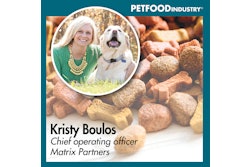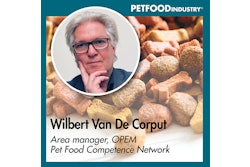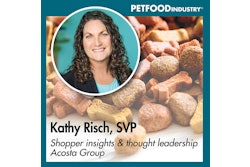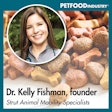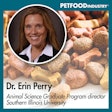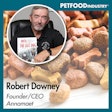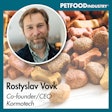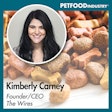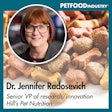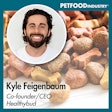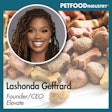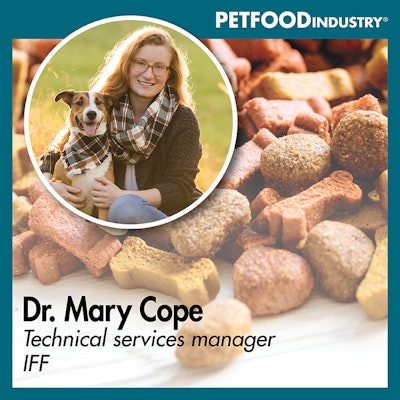
In this episode of Trending: Pet Food, host Lindsay Beaton welcomes Dr. Mary Cope, technical services manager for Pet Nutrition at IFF, to discuss the latest trends in the pet food industry as we approached the midpoint of 2024. Dr. Cope shares her insights on the continued rise of premiumization, humanization and the demand for natural, clean label products. The conversation also delves into the economic dynamics of the pet food market, the evolving role of functional ingredients, and the growing interest in sustainable practices. With an optimistic outlook for the industry's growth, this episode offers valuable perspectives for businesses navigating the ever-evolving pet food landscape.
The below transcript is from Episode 67 of the Trending: Pet Food podcast. Host Lindsay Beaton talks with Dr. Mary Cope, technical services manager at IFF about predicted pet food trends and how they’ve played out so far in 2024. You can find the episode at Trending: Pet Food, on SoundCloud or on your favorite podcast platform. This episode originally aired on August 7, 2024.
We want to thank AFB International for sponsoring this podcast. AFB is the premier supplier of palatants to pet food companies worldwide, offering off-the-shelf and custom solutions and services that make pet food, treats and supplements taste great.
Lindsay Beaton – editor, Petfood Industry magazine, and host, Trending: Pet Food podcast: Hello, and welcome to Trending: Pet Food, the industry podcast where we cover all the latest hot topics and trends in pet food. I’m your host and editor of Petfood Industry magazine Lindsay Beaton, and I’m here today with Dr. Mary Cope, technical services manager for pet nutrition at IFF. Hi Mary, and welcome!
Dr. Mary Cope, technical services manager for pet nutrition at IFF: Hey, Lindsay, thank you so much for having me today.
Beaton: In case you’re unfamiliar with Mary or IFF, here’s what you need to know.
Dr. Cope earned her Ph.D. in Animal Nutrition from the University of Georgia, her MBA from the University of Nebraska-Lincoln, and has a graduate certificate in Companion Animal Nutrition from the University of Illinois. Prior to her time at IFF, Dr. Cope worked as a pet nutritionist at a pet nutrition consulting firm. Outside of work, Dr. Cope competes in a variety of AKC dog sports with her two dogs, including agility, conformation and herding.
IFF’s goal is to apply science and creativity for a better world. Across the company’s business divisions, they’re on a mission to Do More Good for their people, customers, and communities. Every day, IFF leverages its industry-leading product portfolio, unmatched innovation capabilities, and customer-centric approach to become the partner for essential solutions.
Mary’s expertise in pet nutrition and beat on the market, is why I’ve brought her on today to answer this question: How are the predicted pet food trends paying out so far in 2024?
Mary, I want to start off by saying that we are recording this just about right at the halfway mark of the year, and there were a lot of trends coming into the year that the industry predicted. I mostly want to talk to you today about how we think those trends are going and how we think the rest of the year is going to play out.
To kick things off, I would like to know what you think are the top three things that everybody needs to be watching for in pet food right now?
Dr. Cope: As we all know, there's an enormous number of trends that have not just started this year. They're a continuation of multiple years, but I don't see them slowing down anytime soon.
Premiumization in the pet space continues to just take off, and that ties in very closely with the humanization of pet food as well. Those two things are running neck and neck with each other. Consumers are humanizing their pets. They view them as parts of the family. They're not just the dog anymore. They're now getting to the point that people view them like their own children, so they want to give them a premium product.
Because of that, we're seeing more and more human-grade products hit the market. We're seeing different formulations and different product types continue that look very much like products that are created for humans, but they're for pets. I anticipate seeing more of the products that are marketed more towards being a shareable product. These would be products that are for pets, but they're in a product format -- they're in flavors or a type of treat that humans would routinely eat themselves -- but formulated and marketed for pets.
I anticipate seeing customized products continue. Pet parents don't just want to give their pets something that tastes good. Pet parents want to give treats, but they want to feel like they're doing something good for their pet as well. I anticipate products coming out that have nutraceutical properties, not only does it taste good for the pet, but it's doing good for their body as well, and creating customized products to address particular health needs.
Lastly, natural and clean label is going to continue. Pet parents are really striving for the best products that don’t have any artificial preservatives, and if any of those products have sustainability claims as well, that's a bonus. Pet parents, in any way, shape or form, aren't willing to sacrifice quality for their pets, and I do anticipate seeing that trend continue.
Beaton: One of the interesting things that I think has happened throughout this year is none of those are new, right? These are all things that were predicted at the beginning of this year to continue evolving. There are well-established trends over the last several years, even the things like the functional aspects of pet food and treats that you touched on.
I want to get your opinion on the economics of it all, because there's such a dichotomy going on right now in the pet food industry that isn't unique, but it is rare. In terms of what's going on in consumer goods right now, particularly food, in that pet food customers are not willing to trade down, but they are being more price conscious. Yet the things they're looking for -- functional additives, premium products and even something like a shareable product, which would fall more in the premium space just because of its function -- those things have a higher price point.
I want to get your opinion on how you think people are reconciling that within themselves? What does that look like right now, as these two things exist side by side, even though, technically and in other consumer goods segments, they're not.
Dr. Cope: That's a great question. All the data that comes out shows that even though the economy isn't doing great, and people are having to spend more for the same products, pet parents are not cutting what they're spending on their own pets.
The pet market is incredibly stable. Of course, all consumers are going to request more and not want to necessarily see those added benefits come back and lead to a higher increase in cost. However, I think pet parents are getting smarter when it comes to understanding the products that have functionality versus those that are just being leveraged for fancy claims on a bag. With the internet being widely available and accessible, they're asking more questions about what are these ingredients actually doing? Are they doing what they're claiming?
If companies are willing to back their products with science-based and proven to be efficacious ingredients, the consumer will be able to reconcile that increase in cost, because it'll be worth it to them. Because our pets are living longer, they're spending more and more time in that old age or elderly category, pet parents don't just want to see an increase in the lifespan of their pet, but the health span as well. They want their pet to have not just more years, but more good years. Because of that, even though some of these products are increasing in price, pets are not really something that pet parents seem to be cutting their spending on.
Beaton: In terms of the way companies might be shifting their outlook for the rest of the year, are you seeing, or do you think there is any particular trend or category that companies should be shifting their focus toward for the next six months? Do you feel like the industry has a pretty good read on what's going on? What would your advice be in terms of what you think is going to happen for the rest of the year?
Dr. Cope: I do think the industry has a good read on the trends in the market. They're not changing rapidly. As you said, we predicted them at the start of the year. They haven't shifted too much.
I think how they go about catering to those trends should be adjusted to focus more on creating value that the customer wants -- backing things with scientific claims, running studies, trialing products to make sure they do have the health claims that consumers want to see.
Additionally, sustainability. I think is a super interesting topic, because while pet parents in general do care a great deal about sustainability, I don't see them willing to make sacrifices on quality to achieve a sustainability claim.
A lot of what I've seen from market analytics indicate the sustainability claim they want goes into the packaging. They want a recyclable package. When it comes to the ingredients used for the products their pet is going to be consuming, they want a high-quality product, and then, if it's sustainable as well, that's an added benefit.
I don't see pet parents asking for a product that they deem to be of subpar quality but also sustainable. I think that's interesting. I think that's kind of a dichotomy that we must play with as well.
Beaton: Do you think some of that has to do with education? A lot of us grew up on reduce, reuse, recycle, and having that pounded into our heads on commercials and in school and so that's something that's tangible and easy to understand. The intricacies, however, of how an ingredient gets from point A to point B to point C is a little bit more complicated in terms of what it means for sustainability.
Do you think customers just aren't there yet in terms of education, or is some of it a price focus? Why do you think that's happening? Why is packaging getting so much of the focus?
Dr. Cope: Packaging is getting a lot of the focus because, as you pointed out, the reduce, reuse, recycle message. They want to see a package that is created from recycled products or can be recycled itself. I also think there's a lot of questions around ingredients that have sustainability claims, such as meat meals or upcycled ingredients that are technically considered to be byproducts.
The term ‘byproduct’ doesn't necessarily elicit the nicest view in a lot of consumers heads, and that comes back to education as well. What is a byproduct, what's a co-product? Because of that, if they view a byproduct or a co-product to be of lower quality, then that sustainability claim isn't going to trump their viewpoint of an ingredient being lower quality. Whereas the packaging isn't going into their pet. They don't have to worry about feeding the packaging to their pet, so they're not concerned about that having a negative impact in their pet's life.
Beaton: We've talked about what’s interesting with what’s happening with trends in the market. Is there anything else that you've seen evolve this year so far that's really interesting to you? Or is there anything that has surprised you?
Dr. Cope: I can't say there's a lot that has come out that surprised me. I was anticipating some of the alternative protein sources to take off a little faster than they have.
The thing I think is really cool is I'm seeing a lot of pet treats out there that are incorporating more and more flavors and aromas that humans would find enticing, which is super interesting to me, because when I was younger, I feel like the only things you could find on store shelves were going to be the moist, meaty kind of treats, the soft chews that smelled like beef or chicken or a baked cookie. Now all of these pet products out there, they look good enough for me to eat. They smell good to me as well.
When you open that package up, you're getting hit in the face with a blueberry scent or an apple cinnamon scent. That's really interesting, because I don't think those scents and flavors are for the dogs, who do love them. They're more for the human -- to give that experience to the pet parent. Most pet parents are not eating the cookies themselves, so their only way to tell how good it tastes is by touching it, feeling it, smelling it and looking at it.
Touch, smell and sight are the only senses they must interpret the flavor. Because of that, getting a nice aroma to a cookie, nice inclusions in that cookie are super important to pet parents. That's what keeps them going back for more. It's a nice experience for them as well as for their pet.
Also, it's been super interesting to notice some of the packaging coming out for treats is very similar to the packaging for cookies for myself. I'm seeing innovation in that area as well. What can we do to to loop the pet parent into this experience, as well as the pet?
Beaton: You mentioned shareables earlier. Do you feel like that's a natural extension of everything you just talked about?
Dr. Cope: A lot of our pet treats now are human grade, which means they're made with all human-grade ingredients. Technically speaking, a human can eat them. I think shareables are kind of a no-brainer. It is a little tricky. If it's marketed for humans versus pet, it can't be marketed to both. But having a product that's formulated for pets made with all human-grade ingredients a human can eat that it is technically human grade.
I think we'll see more and more people taking their pets out and doing active things with them -- taking them out hiking or to bars. It makes sense to me that if they throw a granola bar in their bag for themselves, they'd want to do the same for their pet. Having a product that is safe for both humans and pets to eat is a natural progression that we're going to see in the market.
Beaton: What do you think is going to be the biggest challenge ahead for the rest of the year?
Dr. Cope: Honestly, regulatory. I think the pet industry is trapped in a lot of boxes, from getting to progress to the point of having shareables that can be marketed for both pets and humans, we're limited on some of the claims we can make and the demographics we can market to. But I don't foresee that being something that will hold the pet industry back at all. It will be something that makes some people shake their heads and go, "You know, I wish we could do this. I wish we could say this, but we can't, because of regulatory."
Beaton: To wrap things up, we've covered a lot of ground in a short amount of time, which always happens when I do an episode that is focused more on trends. People could probably listen to it for ages and are taking notes. What do you think is the primary takeaway? From current pet food market trends. If a company wanted to hone in one thing and really just solidify what they're focusing on for the next six months, what would you say the industry's focus should be on?
Dr. Cope: I think you need to create a premium product that has a clean label with some good, functional claims that are backed by some science to really cater to what pet parents are looking for.
When we talk about trends in the pet industry, the dog space is huge and overshadows the cat space. But cats are a very popular pet as well. I don't think enough attention is given to cats. I think all the trends we observe for pet are present for both dog and cat, and there's a lot of room for innovation, especially coming up with natural, functional nutraceutical blends for cats. I think that's a huge space available in the industry. It will be interesting in the next few years to see what companies come up with to cater to cats specifically as that space continues to grow.
Dogs are notoriously easy to give treats to, and you can hide a lot of functional ingredients in their treats. They're generally not too picky. Cats have a bit more of a refined palate, so coming up with inclusions and treat formats and functional areas for cats will be interesting to watch that one grow as well.
Beaton: I want to touch more on the functional space, because there are so many things to choose from right now when it comes to functionality in pet food and treats. I imagine it can be difficult for companies to figure out what to focus on. Do they do the tried-and-true, like joint health or gut health? Do they try to pave a new way in a segment that's a little less saturated? What are some of the “asks” you think exist both in the cat space and in the dog space, in terms of functional ingredients? Do you think the industry is already meeting them, or is there room for growth anywhere?
Dr. Cope: There's enormous room for growth. There needs to be more investigation into new functional ingredients. It’s difficult for consumers to distinguish what supplements are going to be the best for their pets, because they all use the same little laundry list of functional ingredients. It seems like every company is utilizing the same ingredients for joint health. You have glucosamine and chondroitin for skin and coat. You have your omega fatty acids for dental health. You have dental chews that use that abrasive mechanism to clean the teeth. Some of them have some enzyme function in them.
I think diving a little deeper and finding, for example, for gut health, finding new strains of probiotics. Asking, “Can enzyme supplementation be beneficial for skin and coat health?” Finding new functional ingredients that will really set you apart from the competition, because you have a new functional ingredient to hit the market. Then having some studies to back that up will be very beneficial to set you apart and show that consumer some value, because the market is so overly saturated right now with the same functional ingredients.
It will be interesting to see as science progresses what we come out with, with potentially new probiotic strains, new functional ingredients. I'm very excited for that future.
Beaton: What do you think is the best way to get the science out there? There are a few different avenues for this as well, right? If you're an ingredient company selling to a pet food manufacturer, there's a certain type of science and education that they're literate in that you can give to them, but then they must be able to translate that to their consumers as well.
Do you think it's a strength or a weakness of the industry getting the science out there right now? How do you think we can improve as an industry in terms of educating pet owners on what they should be looking for in an ingredient?
Dr. Cope: This is a larger systemic problem in the scientific community, where we have some super brilliant scientists who are writing some groundbreaking papers, but then it gets lost in translation as it goes down the chain of what the actual value is, what the importance is.
We need to have scientists who conduct experiments, find the data, answer how it's efficacious and how it's beneficial to pets. Then those scientists need to learn how to translate that information in a way that's consumable for a general pet parent.
I always try to keep in mind whenever we're looking at a new product or a new ingredient -- what is the value to the end consumer, to the pet parent? What are they going to take away from this? How is this helping their dog? I want to be able to take that information and tell a random person, a random dog or cat owner on the street, and have them understand it. The scientific community isn't always the best at relaying the data in a way that the marketing team understands it well, so they can relay that benefit to the pet food manufacturer, who can then relay it to the consumer.
There’s a lot of really cool science going on, and it ends with the published paper. We need to continue to take that information and have it go downstream, so people can understand it and know what to choose for their pet, what's going to be the best for their pet, and what's going to help their pet with the issue they're trying to resolve through nutrition.
Beaton: On a scale of extremely optimistic to doomsday, where do you fall in terms of the rest of the year for the pet industry?
Dr. Cope: I would be extremely optimistic about it. I don't foresee the pet industry going anywhere, having any big crashes. People still love their pets. They’re continuing to get more pets. We’re seeing growth in the pet industry. We focus primarily on dog and cat, but we're seeing backyard poultry getting big, so people are continuing to get more animals.
Obviously, it has flattened out a bit since COVID. Everyone went home to stay in isolation and thought, “You know, my life would be a lot nicer if I had a dog or a cat.” We have seen that flatten out a bit. But people love their animals. They're not willing to sacrifice quality. The longer they have their pets and the older they get, they're going to be looking for more products, more supplements to give their pet to help keep them healthy.
I have three dogs and a cat myself, and the vet is a very expensive place for us, so if we can avoid going in the first place outside of our yearly visit that's optimal for us. I know that I'm not alone. An enormous number of pet parents are looking for treats, supplements, foods that convey a nutritional and health benefit to their pets so they can stay out of the vet office and keep their pet healthy, happy and continue to enjoy many years with them. I don't foresee that going anywhere anytime soon. The next six months are looking very optimistic.
Beaton: On that note, I want to thank you very much for coming on today, Mary. There are so many market trend predictions floating around at the beginning of the year and even to right now. It's always good to get a read on things now that we're halfway through the year to see how those trends are shaping up. Before we wrap up today, I always like to do a little plug. Where can people find more information about you and IFF?
Dr. Cope: Absolutely. I'm on LinkedIn. You can also visit our company website, iff.com. We have an enormous number of different products, different flavors and fragrances that can be applied to many different formats of pet treats and food. We have protein solutions and probiotics, enzymes and we're constantly looking for new products to benefit pets with their health and improve pet products in general, for both the pets and the pet parents.
Beaton: Perfect. That's it for this episode of Trending: Pet Food. You can find us on petfoodindustry.com, SoundCloud or your favorite podcast platform. You can also follow us on Instagram @trendingpetfoodpodcast. And if you want to chat or have any feedback, I'd love to hear from you. Feel free to drop me an email: [email protected].
And of course, thanks again to our sponsor AFB International, the premier supplier of palatants to pet food companies worldwide, offering off-the-shelf and custom solutions and services that make pet food treats and supplements taste great.
Once again, I'm Lindsay Beaton, your host and editor of Petfood Industry magazine, and we'll talk to you next time. Thanks for tuning in!


